All about Criminal Motivation, by Mark Gado — Introduction — Crime Library
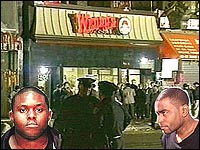
(right inset) & the Wendy’s restaurant in
Queens, NY (AP)
On the night of May 24, 2000, two desperate men walked into a Wendy’s fast food restaurant in Queens, New York City. They were both armed with handguns. The men rounded up the seven employees and took them down to the basement. The hostages were tied with rope and forced to lie down on the floor. Then, one by one, the suspects shot the defenseless employees in the head. Five of the victims died. Within a few days, police arrested John Taylor, 32, and Craig Godineaux, 36, who were charged with the bloody massacre. One of the men was found hiding in his grandmother’s home. Less than $2,000, all in coins, was stolen during the event. Taylor may become the first defendant to receive the death penalty in New York State in 40 years.

Kipland Kinkel, 15, a high school student in Springfield, Oregon, who had just been suspended, went on a shooting rampage on May 21, 1998. Kinkel had killed both his parents earlier in the day and booby-trapped his house with high explosive bombs. One of the bombs was hidden under his mother’s corpse. Later, Kinkel went to school armed with semi-automatic rifles and opened fire on his fellow students. He killed two and wounded 10 others before he was disarmed and captured. His classmates had once called him “most likely to start World War III.”
Whenever a particularly violent or grisly crime grabs the headlines, most people have the same thoughts. Why does crime exist? What causes such mindless violence?
Throughout history, social scientists, physicians, researchers and psychologists have struggled to answer those questions. In Medieval times, it was thought that demons and evil spirits of all types and forms took possession of the individual causing him or her to do bad things. The “witch” hysteria in Salem, Massachusetts, during 1691 is an example of alleged demonic possession that resulted in the murder of innocent people. Even the ancient Romans had a theory about the origins of criminality. They believed that human behavior ebbed and flowed with the phases of the moon. The word “lunacy,” which is derived from the Latin word “luna” for moon, reflected that belief.
But as quickly as some theories appeared, they vanished. Criminological theories have gone through an evolutionary process that still continues today. For what seemed like a valid explanation during one era, bordered on the verge of madness the next. And there is probably no other aspect of social science that is so permeated with superstition, quackery, sensationalism and outright fraud as crime theory.
“The common argument that crime is caused by poverty is a kind of slander on the poor,” H.L. Mencken, journalist
The first organized scientific search for the causes of crime came to be known as the classical school. Theorists proposed that people are rational thinking beings and therefore their behavior is the result of a logical thought process. In 1764, an Italian professor named Cesare Beccaria (1738-1794) published a book called Essays on Crime and Punishment. This study represented a dramatic break with the past. Previously, any form of “justice” focused on the concept of punishment. Beccaria suggested many policy changes in the way criminals should be treated. He said that punishment for a criminal offense should never be excessive and should be used as a deterrent to crime. He also proposed that any punishment should be written down in advance so offenders would know what to expect if they got caught. His innovative ideas of presumption of innocence and the protection of individual liberties later influenced the Constitution of the United States and especially the Bill of Rights.
Following in Beccaria’s footsteps was the Englishman, Jeremy Bentham (1748-1832). He believed that the rational choice theory promoted by Beccaria assumed that people commit crime because the benefit outweighed the cost. Being fond of inventing new words for some of his ideas, Bentham called this thought process the “hedonistic calculus.” He concluded that for people not to commit crime, the punishment had to outweigh the benefit derived from the criminal act. Bentham believed that the goal of punishment should be deterrence. Punishment should be designed to persuade people that criminal activity was not worth the price to be paid.
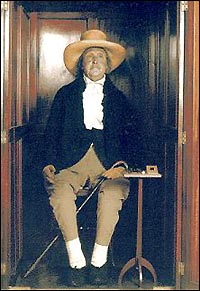
body of Jeremy Bentham (1748-1832),
with head, on display at the University
of London
Bentham was a philosopher, a prolific writer and somewhat of an eccentric. Bentham’s last will and testament directed that his body be preserved at the University of London. When he died in 1832, his embalmed body was dressed in the clothes he usually wore when he was alive and seated in one of his old chairs. He was put on display in the university where students had to pass by him each day. Bentham also directed that a sign be placed over his mummified body with the label “Auto-Icon.” But during the embalming process, something went wrong and his head was ruined. It could not be used in the display. As a result, a wax replica later replaced the real head.
However, successive generations of students found the temptation too much to resist and Bentham’s missing head frequently turned up at parties and sporting events. Legend has it that Bentham’s mummified body regularly attends meetings of the College Council where his presence is always recorded in the minutes by the notation: “Jeremy Bentham, present, but not voting.”
The classical school, whose origins stretched back to the Middle Ages, was a giant step forward for sociologists. Beccaria and Bentham were considered somewhat radical for their time, so ingrained were the principles of punishment in European civilization. But their ideas were an assault on conventional thinking, which convinced society that a better understanding of the nature of crime and the application of justice was needed. With that goal in mind, scientists began to look inward, speculating that for some people, criminality might be inevitable.
“I never knew I had an inventive talent until phrenology told me so. I was a stranger to myself until then!”Thomas Edison, (1847-1931), American inventor
Biological theories of crime causation, most of which were formulated during the 19th century, assumed crime was caused by inherited factors. Some scientists believed that criminal behavior could be traced to physiological origins. The idea that a person’s character can be interpreted by looking at his or her face is derived from ancient times. Even today, we frequently hear expressions such as “she has the face of an angel” or “he looks like a nice guy.”
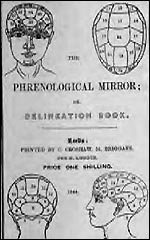
journals to appear during the
19th century
An Austrian physicist, Franz Gall (1758-1828), was the first to present these themes as a science. Gall believed that the shape of the brain and the skull could reveal an individual’s personality and psychological development. This theory, called phrenology, became widely popular and was used for many years in Europe and America. During this time, phrenology journals, which interpreted human skull shapes into psychological profiles, appeared throughout the world. These books made entertaining reading and soon phrenology became the rage of 19th century intellectuals. Even Edgar Allen Poe was a believer in phrenology and examples can be found in some of his writings such as The Fall of Usher and The Black Cat. Some phrenologists claimed that it was possible to predict the aggressive nature of criminals by a simple skull examination.
Gall believed that the brain contained all the morals, sentiments and properties a person could have. He said that the form and shape of the human head correlates directly to the abundance or lack of certain personality traits. Thus, certain areas of the brain were the localities for aggressions, hostility, destructiveness and secretiveness. Depending on which phrenology expert was consulted, there were 27 to 38 regions on the head that were associated to personality traits. If these areas were expanded or more pronounced than a “normal” head, then that person would demonstrate more of those traits. Skull maps by the hundreds were devised that showed where these critical areas were located.
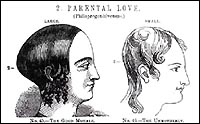
depicting a comparison between a “good
mother” and the “unmotherly.”
Other scientists joined the phrenology parade and the “new science”, as it was called, became a sensation. Even politicians and judges became enamored with the possibilities of predicting human behavior. Attempts were made to legitimize phrenology by using it in America’s courtrooms. In 1927, a well-known phrenologist, Dr. Edgar Beall was called in to perform a reading on Ruth Snyder, accused of murdering her husband. Dr. Beall decided that Snyder’s chin “tapered like the lower face of a cat” which proved her “treachery” and “ingratitude.” Her mouth was as “cold and hard and unsympathetic as a crack in a dried lemon.” Beall’s final analysis, after studying Ruth Snyder’s face, was that she had “the character of a shallow-brained pleasure seeker…murderous passion and lust.” These descriptions were printed in newspapers of the time and treated as fact.
Phrenologists also began to branch out into other areas of society. They were consulted in medicine, politics and used in the arts as well. Criminals were thought to have damaged brains that produced an over-abundance of aggression or hostility. Phrenologists believed this condition was caused by outside influences that stimulated the brain to overdevelop. These outside influences included lethargy, booze, masturbation and too much study as a child or too much religion. Criminals should be placed in a “moral hospital” where they would be taught good things and cut off from bad influences. Some phrenologists wanted to imprison people based on the results of a skull examination if it showed even a potential for hostility.
Gradually, phrenology began to fall from favor. Unscrupulous entrepreneurs and con men traveled the country, bilking people out of money and valuables with false readings. Phony “scientists” seemed to be everywhere, offering to give expensive lectures on the latest “advances” in the new sciences. Odd machines that automatically provided a phrenological reading of the skull began to appear at movie theaters and department stores. A person would sit in a chair and a metal helmet was placed on the head which measured bumps and crevices in the skull. A report would then print out a detailed reading of the patient’s personality. One of these phrenology machines can still be seen today at the Museum of Questionable Medical Devices in Minneapolis.
By the 1930s, phrenology had come under heavy criticism on many different fronts. Physicians, psychologists, scientists and universities began to attack the entire concept of phrenology. Defects in Gall’s theories were exposed. One of the major failings of phrenology was that it made no sense that soft brain tissue could cause indentations in the skull. Additionally, the regions of the brain assigned to specific personality traits varied from one phrenologist to the next. Finally, people realized there was no hard evidence to support any of Gall’s theories.
Eventually, phrenology became quackery and the theorists moved on.
“At the sight of that skull, I seemed to see all of a sudden, lighted up as a vast plain under a flaming sky, the problem of the nature of the criminal!” physician Cesare Lombroso as he performed an autopsy on a Italian convict in 1894.
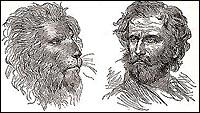
and psychological relationship between
man and animal. From: New Physiognomy
or Signs of Character (1871)
Despite the failures of phrenology, the mysterious connection between crime and physiology persisted. Cesare Lombroso, (1835-1909) was the next researcher to build upon the theories of Gall. Lombroso was an Italian physician who performed hundreds of post mortem examinations on criminals during the late 19th century. He noticed that many of these criminals shared some of the same physical characteristics. Lombroso compiled a list of these characteristics which included receding hairline, forehead wrinkles, bumpy face, broad noses, fleshy lips, sloping shoulders, long arms and pointy fingers. Lombroso associated these stigmata with primitive man. This condition was called {atavism}. Its theological roots were firmly embedded in one of the most influential books ever written, Charles Darwin’s The Origin of the Species, published in the 1870s.

(CORBIS)
Lombroso became convinced that a criminal was an immoral person, a sort of throwback to primitive man who had not developed to the same biological level as the modern, non-criminal man. Lombroso called this inferior being the “born criminal”, a being who was pre-destined for criminal behavior due to his physical configuration. According to Lombroso, the “born criminal” descended from a “degenerate family with frequent cases of insanity, deafness, syphilis, epilepsy and alcoholism among its members.”

ed resemblance between appearance and
personality. From: New Physiognomy or
Signs of Character (1871)
Lombroso also became fascinated with the practice of tattooing which he associated with criminality. In a famous article titled The Savage Art of Tattooing, which he wrote for Popular Science in 1896, Lombroso described his revulsion to tattoos. “Certainly these tattooings declare more than any official brief to reveal to us the fierce and obscene hearts of these unfortunates,” he wrote. From his narrow observations of prisoners, Lombroso made sweeping assumptions. “Among eighty-nine tattooed persons,” he said, “I saw seventy-one who had been tattooed in prison.” Because he believed tattooing was prevalent in criminals, Lombroso deduced that criminals had a higher tolerance to pain. “Tattooing is, in fact, one of the essential characteristics of primitive man,” he said, “and of men who still live in the savage state.”
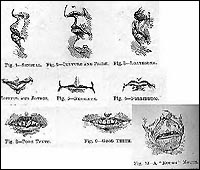
Lombroso, some of which may indicate
criminality. From: New Physiognomy or
Signs of Character (1871)
However, Lombroso’s theories began to unravel when several weaknesses were discovered in his research. Virtually all of Lombroso’s presumptions were based on studies performed only on convicted criminals. He did not use a control group to which he could compare his results. Therefore, his conclusions could not be broadened to include the general population as a whole. This basic flaw in his research came to be known as “the Lombrosian fallacy.” Years later, Charles Goring, an English physician who took an interest in Lombroso’s theories, decided to examine more closely some of his conclusions. Goring studied thousands of prisoners in British jails. He compared their physiological traits to members of a military unit, the Royal Engineers. Goring found no substantial differences between the two groups. He published the results in a book called The English Convict in 1913. Goring proved that atavism had no scientific support and the data he gathered essentially discredited Lombroso’s idea of a “born criminal” forever.
“What do I know of man’s destiny? I could tell you more about radishes,” Samuel Beckett (1906-1989) playwright, poet
Although Lombroso’s research was discredited, the belief that scientists could successfully identify a criminal type continued. During the 19th century, long before the Corleone family became famous through Mario Puzo’s novel The Godfather, the concept of criminal families became popular. In the late 19th century, sociologist Richard Dugdale, published The Jukes: A Study in Crime, Pauperism, Disease and Heredity. Dugdale investigated the hereditary line of a family he called the Jukes in upstate New York. Hundreds of descendents of the Juke family (a pseudonym) were traced through successive generations that went as far back as Colonial times.
Dugdale managed to study 709 persons with the Juke name. Those that married into the family and thereby not considered of pure Juke lineage totaled 169. Dugdale once estimated that if he were able to track every single member of the Juke family, the total would have exceeded 1,200 people. But of the 709 he was able to study, 180 had been in the “poorhouse” or received public assistance. Dugdale found 140 criminals or offenders. There were 60 “thieves,” 7 murder victims, 50 prostitutes and 40 women who had contracted sexually transmitted diseases. Dugdale was able to estimate that the Jukes had cost the State of New York almost $1.4 million dollars to house, institutionalize and treat the family of deviants.
A follow-up study conducted in 1915 by Arthur H. Estabrook encompassed 2,820 Jukes and found similarly depressing results, only on a larger scale. “Children grew up in an atmosphere of poverty, crime and licentiousness. The girls and young women of these families were very comely in appearance and loose in morals,” wrote Estabrook. These women attracted non-Juke men from nearby towns and produced offspring that were descended from “respectable” families. “In this way,” wrote Estabrook, “syphilis has been spread from these harlots to the good and virtuous wives in the nearby community.”
The psychologist Henry Goddard later conducted a similar research project in 1912 published as The Kallikak Family: A Study in the Hereditary of Feeble-Mindedness. He studied two separate lines of the Kallikak family. One line originated from Martin Kallikak, a Revolutionary War soldier and a feeble minded bar maid. This union eventually produced 480 descendents of which more than half were described as deviant or criminal. The second line originated from the same Martin Kallikak and a Quaker girl from Philadelphia, a female with an ostensibly “better” hereditary ingredients than the barmaid. This union led to 496 descendents. None became criminals and only three were characterized as abnormal. However, Goddard’s work was highly questionable and some critics have said that the entire study was fictitious, invented by Goddard to promote his radical views and obvious distaste for people he labeled “feeble-minded.”
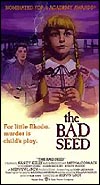
a dark story of a 12
year old murderess
and suspicions of
genetic destiny.
Studies of criminal families, like the Jukes and the Kallikak, captured the imagination of the public who began to believe that there could be a “criminal” gene that was being passed from one generation to the next. Although Dugdale and Goddard’s research contained serious flaws and were openly challenged over the years, their ideas took hold on the general public. The memorable film The Bad Seed (1956) was an example of inherited criminal behavior. In this story, originally made popular as a Broadway play, a small girl becomes a murderess at an early age, allegedly because she descended from “bad genes.”
Goddard also believed in selective breeding for human beings. He said in The Kallikaks “they were feebleminded and no amount of education or good environment can change a feebleminded individual into a normal one, anymore than it can change a red-haired stock into a black-haired stock.” Although the idea of genetic manipulation is ancient, Goddard worked hard to publicize the idea that people could be improved by improving the quality of the gene. This concept was called eugenics.

Oliver Wendell Holmes
(AP)
Fueling this new movement was an underlying belief that criminal behavior could be controlled by genetics, a notion that had harsh racial undertones. Eugenics became widely accepted in America and was even endorsed by Supreme Court Justice Oliver Wendell Holmes. In the Supreme Court decision Beck v. Bell (274 U.S. 200, 1927), Holmes wrote in defense of forced sterilization: “It is better for all the world, if instead of waiting to execute degenerate offspring for their crime…society can prevent those persons who are manifestly unfit from continuing their kind.” The Beck v. Bell ruling was used as the justification to forcibly sterilize thousands of American citizens against their will. This process continued until 1942 when the Supreme Court declared the practice unconstitutional in Skinner v. Oklahoma.
But Goddard’s work, flawed and baseless as it was, was destined for a much more ominous role in history. The Kallikak Family was published in Germany in 1914 and again in 1933 when the Nazis, led by the demonic Adolph Hitler came to power. The similarities between ideas expressed in Goddard’s research and Hitler’s twisted vision of an Aryan race are striking.
“The streets are safe in Philadelphia, it’s only the people who make them unsafe,” Frank Rizzo, ex-police chief and former mayor of Philadelphia
Does the way we look have anything to do with the way we behave? Do our bodies predispose us to a predictable behavioral pattern? An American psychologist named William Sheldon (1898-1977) thought so. For decades, Sheldon examined the relationship between physical attributes and personality development. In 1940, Sheldon studied several hundred juvenile offenders in Boston, paying close attention to the structure of their bodies. He took thousands of photographs of naked young men, both frontal and profile view. Based on his meticulous observations, Sheldon managed to classify the body structures of these offenders into three general but distinct categories. The groups consisted of mesomorphs, who had a stocky, muscular build, ectomorphs who were thin and fragile and finally endomorphs who were described as soft, round with short limbs.

Carryl Chessman and Albert DeSalvo
(CORBIS)
Sheldon used an ingenious numerical scale to grade the varying degrees of these characteristics in each individual. He recognized that people could possess varying degrees of each body build. He assigned a number of 1 through 7 to measure the amount of each type. Thus, a “pure” mesomorph would be a 7-1-1 type. A “pure” ectomorph would be a 1-7-1. A person with traits of both body types could be a 2-6-1 and so on.
Sheldon then interviewed hundreds of men and divided their personality characteristics into three categories. Sheldon believed that each body type had a corresponding and predictable personality profile.
- endotonia which was the love of physical comfort, food and socializing
- mesotonia which was the love of physical action and ambition
- ectotonia which centers on privacy and restraint
Sheldon found that there was a strong correlation between mesotonia and mesomorphs. The body type that was muscular and angular meshed with an action-loving, aggressive personality. Sheldon concluded this type of person, which he called mesotonic, most often descended into criminality. They slept the least, had higher blood pressure and were quick to anger. They were prone to gambling and very assertive in their dealings with others. Examples of the mesotonic could be found in every American prison and Sheldon saw this as a confirmation of his theories. It was easy for criminologists to point to people such as serial killer Charles Starkweather, Carryl Chessman, “The Red Light Bandit,” Billy “Hard Luck” Cook, Albert DeSalvo, the alleged Boston Strangler, and many more who fit Sheldon’s profile of the mesotonic criminal. Other criminals who did not fit the mesotonic parameters were simply ignored.
But psychologists were not convinced. For every mesotonic that committed crimes, there were just as many who did not. And there were many overweight criminals in jail. Sheldon’s research remained mostly unproven, although his observations on body types and personalities provided a massive framework for a generation of researchers.
“All of them!” Andrea Yates on June 20, 2001 when her husband, Russell, asked her which of their five children did she kill.
Ever since 12 year-old Hannah Occuish was hanged in New London, Connecticut, in 1787 for the murder of a 6-year-old girl in a dispute over strawberries, female criminality has spawned its own brand of crime theories (Occuish may be the youngest person legally executed in American history). Of course, most of these theories are unique to women and cannot be shared by the male population. Pre-menstrual syndrome (PMS) and post-partum depression syndrome (PPDS) have been used in several murder cases during the 1990s which generated a great deal of publicity. Although the perception may be different, PMS as a causal factor in female crime is not new.
In the late 19th century, Lombroso began with the basic misconception that female criminality correlates to hormonal factors and chemical imbalances that originate with the menstrual cycle. It was thought that menstruation could cause a variety of conditions like migraine, epilepsy, kleptomania, pyromania, suicide and even homicide. This line of thinking continued throughout the century. In 1945, a study found that “84 percent of women’s crimes of violence are committed during the premenstrual and the early menstrual periods” (Vito and Holmes). A later study seemed to confirm that finding when it was discovered that 80 percent of violent acts committed by women convicts in New York were committed during their menstrual period (Vito and Holmes). Despite these examples, however, current research does not support a direct relationship between a woman’s menstrual period and female criminality. It is just as likely that the psychological stress of hostility and violence brings on the menstrual cycle. The conclusions drawn during many of the earlier studies were based on stereotypical attitudes and sweeping assumptions of the female sex. Post-partum depression is also coming under much more scrutiny ever since a tragic murder case in Texas in 2001.

ted of the murder of her
five children (AP)
Andrea Yates, 36, who drowned her five children in Houston, Texas, on June 20, 2001, was said to be suffering from a severe case of PPDS when she committed the murders. At the Yates trial, her attorney, George McCall Secrest told CNN, “The jury is going to have to focus not only on the facts of the actual offense on trial but they’re going to have to understand the mental state of mind of the accused.” Secrest knew what he was talking about. In 1997, he defended a Texas woman who killed her 4-month-old baby because she thought the child was possessed by demons. The woman was found not guilty by reason of insanity. Andrea Yates was not that lucky. In March 2002, a jury deliberated less than four hours and found her guilty of the five murders. She was later sentenced to life in prison.
Another example of a post-partum depression homicide occurred in New York in 2001 when 38-year-old Susan Mooney murdered her 7-month-old son by placing her hand over his mouth. At her murder trial, a doctor testified that Mooney “was confused, and being driven by internal stimuli that were not part of reality.” Like many other homicides committed by mothers who recently gave birth, the post-partum explanation was offered as a defense. As in most other cases of this type, that explanation will probably be rejected. Juries are historically reluctant to excuse a mother for the murder of her children for almost any reason.
Although women compromise approximately 51% of the population, they make up less than 10% of serial killers. The differences between male and female murderers are many. A recent study revealed that female serial killers were older than their male counterparts and were more likely to be drug abusers and alcoholics. Women were found to be suffering from a litany of psychological disorders while males were most often sociopaths. Female serial killers usually poisoned or smothered their victims who were previously known to them. Men usually stalked their prey while women, like Aileen Wournos and Louise Peete, who may have killed six men, most often lured victims to their deaths. In another study of 14 female killers, all were found to have suffered from abusive relationships in dysfunctional families, almost a trademark of all female killers.
Louise Preslar Peete, sometimes called a “Dr. Jekyll and Mrs. Hyde,” was raised in an aristocratic Louisiana family. She was the typical Southern belle: educated, refined and attractive. Unfortunately, Louise was also unprincipled and cunning. She shot and killed her boyfriend when she was just 21 years old in 1903. When she later appeared before a grand jury, she convinced the panel she was defending herself against a sexual assault. Sentenced to life in 1923 for the murder of her husband, she managed to obtain a parole in 1942. Upon her release, Louise then murdered an elderly widow to get control of her estate. Peete went to the San Quentin gas chamber on April 11, 1947. She maintained her composure to the end, always mindful of her cultured upbringing. Her last words to the executioner were: “Thank you for all your many kindnesses!”
“I’m no ordinary killer!” accused murderer Raymond Fernandez told Michigan cops in 1950 when he was arrested for one of 17 suspected murders.

rooftop sniper, who
shot 48 people on
August 1, 1966 (AP)
Brain irregularities or physical trauma, such as head injury, may also play a role in criminality. Although research indicates brain damage can cause a sudden personality change, it is not true in each and every case. On August 1, 1966, a distraught Charles Whitman, 24, climbed to the top of a 307-foot observation tower at the University of Texas in Austin. A few hours before, he had stabbed his mother to death and shot her in the back of the head. An ex-Marine who had a fascination about guns, Whitman brought a formidable arsenal with him. For nearly two hours, using a high-powered rifle, he randomly shot 48 people, killing 18. The day before, he left a note that read: “After my death, I wish an autopsy on me to be performed to see if there is any mental disorder.” During the postmortem exam, doctors discovered that Whitman had a severe brain tumor. But whether it had been the cause of Whitman’s murderous rampage was never proven.
One of the most famous brain injuries on record is the fascinating case of the “crowbar incident,” which occurred in Virginia on September 13, 1848. A 24-year-old railroad worker, Phineas P. Gage, was caught in a powerful explosion during a construction accident. A steel rod, 3.5 foot in length, known as a tamping iron, became airborne and pierced the skull of Phineas Gage. The iron entered the top of his head, passed through the brain and exited through the lower portion of the left cheek, leaving a gaping hole. Gage never lost consciousness and spoke with his co-workers several minutes after the event. He was taken to a hotel where he walked unassisted up stairs. “He bore his sufferings with firmness,” Dr. J. M. Harlow, the treating physician, later wrote, “and directed my attention to the hole in his cheek, saying, ‘the iron entered there and passed through my head!”

Phineas P. Gage on September 13, 1848,
now on display at Harvard University.
Gage survived. But his personality had undergone a dramatic change. Whereas before he was the capable and efficient foreman on the job, Phineas Gage became sloppy, careless and argumentative. “The equilibrium or balance between his intellectual faculties and his animal propensities seemed to have been destroyed,” said the doctor. Gage was later dismissed from his job and became somewhat of a reclusive figure. “His mind is radically changed,” wrote Dr. Harlow, “so decidedly that his friends said he was no longer Gage!” But because of his fantastic injury, Gage became famous. He even appeared in P.T. Barnum’s American Museum in New York City. His skull and the iron bar that pierced it are on display at Harvard University.
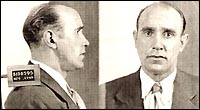
at Sing Sing 1951
In a similar case many years later, a head injury may have transformed a man into a serial killer. During an ocean voyage to America in 1945, Raymond Fernandez, 30, experienced a life-changing event. As the young man climbed a flight of steps to the ship’s main deck, a hatch cover slammed onto the top of his head. Fernandez suffered a serious concussion and remained in a coma for a week. When he awoke, it was clear that he had undergone a personality transformation. Whereas before he was courteous, well mannered and displayed an even disposition, he soon became argumentative, quick to anger and difficult to control. Over the next few years, Fernandez may have murdered 17 women with the help of his girlfriend, Martha Beck. They were eventually executed at Sing Sing prison in 1951.
Another murder case, which sparked a great deal of controversy and increased racial tensions as well, was the story of NYPD Officer Robert Torsney. On Thanksgiving Day in 1976, Torsney, who was white, shot and killed a 15-year-old black youth on a Brooklyn street for no apparent reason. Torsney was later indicted and charged with murder. At his trial in November of 1977, Torsney’s attorney said that his client was suffering a rare form of “psychomotor seizure” which caused him to black out for a few seconds resulting in a total memory loss. This condition, which a psychiatrist called “Automatism of Penfield”, apparently was so rare, no one had ever heard of it until the trial. The jury seemed to agree because Torsney was found not guilty by reason of insanity. He later spent less than two years confined to a mental institution where he was allowed to go home on most weekends.
However, cases such as Torsney’s are exceptional. In most situations where a defendant suffers a head injury or sustains brain damage through a disease, courts usually will not accept that as an excuse for murder. Most head trauma victims do not immediately go out and commit crimes. But mental instability, in all its forms, has been used in courts for nearly two centuries to explain why people commit crimes.
“My mother and I were very happy, extremely happy, more than happy,” Alan Bates in Psycho (1961), who years before, murdered his mother in a jealous rage.

classic film, Psycho
(1960)
When we use the term “psycho”, many people conjure up the image of Anthony Perkins as the murderous innkeeper in Hitchcock’s film classic Psycho,(1961), which scared the hell out of audiences in the 1960s. But the reality of a psychopathic personality is much different than the Alan Bates character in the movie. The psychopath is most often not a killer or a schizophrenic with multiple personalities. The majority of psychopaths lead somewhat normal lives and never commit an act of violence, though they may wreak havoc wherever they go.
Psychological theories assume that crime is a result of poorly conditioned behavior or a dysfunctional personality. Sigmund Freud (1856-1939) developed a set of psychological concepts that profoundly affected the criminological world. Freud believed that human behavior is best understood through psychoanalysis which probes the innermost thoughts of the individual. Freudian psychologists believe that a dysfunctional personality can have a wide array of causes, such as improper learning or early childhood trauma, which result in an adult mental imbalance. In an extensive study of serial killers, researchers found that they suffered from varying degrees and types of trauma in their youth.

serial killer Henry Lee
Lucas, executed in
Texas
Psychologists say that a childhood psychological disturbance can be so overwhelming that it can cause later deviant behavior. Mental anguish of this severity manifests itself in many modern-day serial killers such as Ted Bundy, Jeffrey Dahmer and David Berkowitz. After their capture, some of these killers have produced paintings and drawings in prison which, some say, display further evidence of their emotional scars. Serial killer art has appeared on eBay and some of this controversial work has turned up in the nation’s auction houses. Arthur Shawcross, the “Genesee River Killer,” convicted of 16 murders in upstate New York, had his paint privileges revoked in 1999 when it was discovered that one of his paintings was being sold on the Internet.

Jeffrey McDonald con-
victed of the murders
of his wife and two
daughters in 1970.
(AP)
The psychopath, also called a sociopath, is a personality that is characterized by cruelty, egotism, impulsive conduct and no remorse for his or her actions. Other traits include selfishness and an inability to give love and affection to others. True loyalty, warmth and compassion are foreign to psychopaths and they usually do not respond to acts of kindness. They have a remarkable disregard for truth and often become pathological or compulsive liars. Antisocial personalities usually do not perceive their behavior as dysfunctional because they see themselves as normal and often feel persecuted by society. They do not anticipate personal consequences and, even under high-pressure conditions, they remain cool and calm in their demeanor. They have been called moral idiots and their conduct is usually motivated by an excessive physiological need for thrills and excitement. O.J. Simpson has been described as a sociopathic personality. So has Ted Bundy, Charles Manson and Captain Jeffrey McDonald, the Green Beret doctor who murdered his family in 1970. Studies indicate that 3% of the male population may have an antisocial personality (Encarta ’99). Psychopaths frequently violate the rights of others and as such, they usually come into contact with the police. They will continue their criminal careers throughout their lives, unlike other criminals who usually burn out as they get older. Ultimately, psychopaths frequently wind up in jail or prison. It has been estimated that as much as 30% of the prison population can be classified as sociopathic.
“Why their crimes are worse than mine! Ten times worse!” the ill-fated James Allen of the judges and politicians in I Am a Fugitive (1932) when he is told that he has to complete his sentence on a Georgia chain gang.
The “father of sociology”, Emile Durkheim (1858-1917), had a life-long interest in crime and its role in society. His innovative ideas on how social structure affects human behavior influenced sociologists for generations to come. Durkheim believed that crime is natural behavior whose composition is the result of many diversified forces.
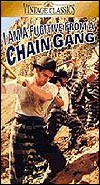
Fugitive (1932), a
powerful film with a
timely social mes-
sage
Durkheim’s ideas led to the famous Chicago School of Sociology, a set of principles that became very popular in the 1930s. This school of thought focused upon society as the embryonic force behind criminal behavior. During the 1920s and 1930s, the Great Depression transformed the political, financial and social landscape of America. The terrible cycle of unemployment, poverty and despair altered the American psyche as well. Banks, corporations and government institutions were perceived as the real enemies of the people then. Even violent and notorious criminals, like John Dillinger, Bonnie and Clyde and especially Pretty Boy Floyd, immortalized in Steinbeck’s The Grapes of Wrath, were viewed by the public as quasi-heroes and somewhat justified in their crimes. They were often thought of as outlaws rebelling against unjust sociological forces. Films of that era, such as I Am a Fugitive (1932) reflected that belief as well. The plot revolves around a war veteran named James Allen who is arrested and convicted for a crime he did not commit. Although an honest man, he eventually is forced into a life of crime by society’s institutions. This was an extremely powerful message during the Depression era.

described as the
“world’s worst
demon” for killing
dozens of children
in a school explo-
sion in Michigan
in 1927
In 1927, a deeply disturbed farmer in Michigan named Andrew Kehoe, 55, committed a despicable crime. Embittered by years of imagined persecution by a local school board and a burdensome tax code which threatened to take away his farm, Kehoe planted as much as 1,000 pounds of dynamite under the floors of the Bath Consolidated School. He detonated this bomb on the morning of May 18, 1927, while school was in session, killing 42 children and injuring over 60 others. When police later searched his farm, they found a sign, painted earlier by Kehoe, which read, “criminals are made, not born.”
Robert Merton, a disciple of Durkheim, said criminal acts were the result of socially created behavior rather than momentary impulses. Merton said that society offers the same goals and rewards to all its citizens. But the means and opportunity to reach these goals are not the same for everyone in society. As a result, anomie, French for “normlessness” results. Merton said people will commit crimes because they feel cheated out of something to which they were entitled.
However, anomie couldn’t explain white-collar crime in which the perpetrators are usually wealthy, educated and not deprived from any of society’s rewards. It simply didn’t seem logical that people who were already rich would steal more money because they felt “cheated.” For those crimes, the explanation had to be elsewhere.
“He who dies with the most toys wins,” — a popular anecdote seen on T-shirts during the 1990s
In what may turn out to be one of the biggest cases of fraud and illegal stock manipulation in the history of crime, Enron Corporation executives were arrested and charged with a wide array of crimes in 2002 involving the collapse of the company. Tens of thousands of stock shareholders were affected. Pension funds evaporated. Thousands of employees lost their jobs. Sadly, it was just one of many business conglomerates that seemed to have been systematically looted by greedy corporate criminals who displayed little remorse for their crimes. In one instance, an Enron executive constructed a $37 million home in Florida while the company was collapsing around him.
Why do these millionaires, surrounded by wealth and privilege, descend into criminality when they already have most of what American life has to offer?
One theory is that executives learn how to steal from other executives. Sociologist Edwin Sutherland said that people will learn how to commit crimes primarily through close interaction with other groups like themselves. They not only learn how but also develop the attitudes and rationalization to support it. Those that live and socialize within the higher economic classes of American society naturally share the same ethical values. They see real “crime” as something that belongs to a social class other than their own. Corporate criminals see their activities as “business” or “profit-taking.” Their motives are often reinforced by the notion that “everyone does it.” And when they’re caught, they have lots of support from family and friends who perceive their acts in much the same way.

In 1970, the Ford Pinto scandal rocked the business world and exposed the type of motivation behind white-collar crime. The Ford Pinto was designed quickly by the Ford Motor Company to compete with European cars that were grabbing a larger share of the American dollar. However, the basic design of the vehicle exposed the gas tank to a greater risk of explosion in the event of a rear end impact. Over the next few years, dozens of people were killed when the Pinto gas tanks exploded in fiery crashes. The Ford Motor Corporation was indicted for reckless murder. At a sensational trial in 1974, Ford executives explained their decision to leave the gas tank design “as is” by offering a “cost benefit analysis” (CBA) which showed that it was much too expensive to retool the car, even though it might have saved lives. The total savings for each vehicle was estimated to be $11. Ford accountants saw no problem with the explanation because this was a business decision fully supported by the CBA. Ford was later acquitted of all murder charges on a technicality.
When the powerful commit crimes, they indulge in offenses that are different from “ordinary” criminals. Corporate executives do not hold up bodegas, steal cars, shoplift or commit muggings. Rather, they trade stocks on inside information, take kickbacks, commit frauds and intentionally default on government loans. The impact of their crimes can be enormous. One instance of corporate crime can affect the lives of tens of thousands of people. But the ordinary citizen does not have the knowledge, expertise or opportunity to commit corporate crime. Only certain people can perpetrate these crimes and therefore their motivations are different. White-collar criminals often cite a powerful peer pressure to maintain their current lifestyle as a factor in their criminality. Others say that they are simply pursuing a sort of twisted image of the American Dream: the attainment of material wealth at any cost. To them, it makes economic sense to steal.
“Television has brought murder back into the home-where it belongs,” Alfred Hitchcock (1899-1980), writer, movie director.
Today, in the United States, 98% of all homes have at least one television, more than have telephones or even bathtubs. By the time the average American child reaches the age of 12, he or she has viewed over 8,000 murders on television. Children shows are frequently the worst offenders. A University of Pennsylvania study discovered children’s programs contained an average of 32 violent acts per hour and 56% of those shows had violent characters. The same study also found that 74% of the Saturday morning shows displayed characters that became the victims of violence. What is all this violence doing to America’s children? Does viewing violent television shows and movies cause violence and crime?
Numerous studies have been undertaken in the past 50 years to investigate the connection between television and crime. Some critics have been vociferous in their belief that watching violence promotes violence. Almost all of the available data on the subject has found disturbing connections between TV viewing and real world violence, not only here in the United States, but in Europe and Australia as well. TV Guide said as early as 1977: “In one survey of 208 prison convicts, 9 of 10 admitted that they learned new criminal tricks by watching crime programs. And 4 out of 10 said they had attempted specific crimes seen on television.”
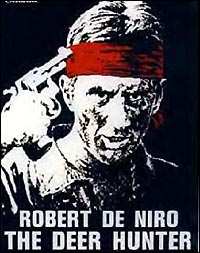
The Deer Hunter (1976) starring
Robert DeNiro
Movies, especially, have come under heavy criticism for their emphasis on killing and gratuitous violence. On April 20, 1999, the 110th anniversary of Adolph Hitler’s birth, two students went on a shooting rampage in Littleton, Colorado, at the Columbine High School. Wearing long, black trench coats, the students walked through the hallways shooting at students indiscriminately. They shot 38 classmates, killing 13 before they turned the guns on themselves. The event was eerily reminiscent of a scene in a popular youth film of the time in which angry students clad in long, dark coats and armed with shotguns killed their teachers. Another movie, which had an unanticipated effect on its audience, was The Deer Hunter (1972) directed by Michael Cimino. The film received several Academy Awards for its disturbing portrayal of how the Vietnam War affected a small Pennsylvania town. The Deer Hunter contains a harrowing scene in which a character plays a deadly game of “Russian roulette.” The film has been linked to at least 43 deaths in a similar fashion.
What is the destiny of children who watch thousands of hours of violence saturated movies and television shows before they even reach their teenage years?
We may never know. Except to say it must have some effect, for it seems impossible that it could have no effect. In one 1995 survey, “57% of the public thinks violence in the media is a major factor in real life violence” of every sort (Schmalleger). But it would still be an overstatement to assume that television viewing alone causes crime or violence. After all, the overwhelming majority of young television viewers do not commit acts of violence, nor do they become delinquents. But if we accept the American Psychological Association report, which said, “The irrefutable conclusion is that viewing violence increases violence” (Myers), then it is truly bad news for America, for television has impacted upon our culture with all the subtlety of a sledgehammer. It has become so much a part of our lives and permeated every level of our social consciousness, that it may be impossible to judge its influence on those that sit hypnotized in its presence for untold hours of their youth.
“You are what you eat” an old anecdote of unknown origin
During the 20th century, a more diversified and imaginative set of crime theories appeared. These concepts highlighted the role of DNA, nutrition, body chemistry and even ecological factors in criminal behavior. One of these theories was the extra chromosome theory, which became popular in the 1960s and was made famous by several high-profile criminal cases in which the defendant was said to have an extra Y chromosome.

of eight nurses in
Chicago in 1966. He
later died in prison
in 1999
When human chromosomes are examined under an electron microscope each gender has a distinctive pattern. Females have a “XX” pattern and a typical male possesses a configuration that appears to be “XY”. In the early 1960s, a researcher discovered that men who had a chromosome pattern of “XYY” were much more prevalent in prisons than in the general populations. These individuals were called “supermales” and were characterized as overly aggressive, hostile and more prone to deviant behavior. The most notorious of these supposed “supermales” was the demented killer of eight nurses in Chicago in 1966 named Richard Speck. It was believed, and highly publicized, that Speck possessed the dreaded extra “Y” chromosome. Years later, it was discovered that Speck did not have the pattern and the “XYY” theory eventually fell into disrepute almost as fast as it became popular.
Nutritional factors were also suspected of having unpredictable effects on the human brain. One of the earliest studies that investigated the link between behavior and diet was completed in 1943. This research found a correlation between low blood sugar and murder. It was said that low blood sugar lowered the ability of the mind to make rational decisions. In recent years, allergic reactions to food have also been used to explain criminal behavior. The famous “Twinkie Defense” in San Francisco is an example of that trend.
In 1978, former police officer Dan White burst into San Francisco Mayor Moscone’s office and shot him and Councilman Harvey Milk to death. His attorney later explained that White was suffering from some type of mental imbalance that caused him to eat a great deal of junk food, including Twinkies. Though the claim was never actually made at trial, the so-called “Twinkie Defense” came to mean that eating junk food can cause deviant behavior. Although he was convicted, Dan White received a more lenient prison sentence. Several years after his release, White committed suicide. But “junk food” was an imprecise term because not everyone thinks the same of “junk food”. What is bad to one person might be nutritious to another, such as pizza or burgers.
Allergic reactions to certain types of food and artificial additives have also been associated with psychological disorders. As can be imagined, it is extremely difficult to prove conclusively that any type of food can generate deviance in any one person. In 1983 in San Ysidro, California, James Oliver Huberty, burst into a McDonald’s fast food restaurant and killed 21 people with an automatic weapon. His wife later brought a lawsuit against the hamburger chain because she claimed that the additives inside Chicken McNuggets caused her husband to go on a rampage.
In Italy, a research project in 1969 discovered that children who consumed large amounts of pasta and bread had shortened memory and attention spans. Research has also confirmed that adjusting the diet of convicts in a controlled setting was more effective than other methods in order to reduce aggression (Vito and Holmes). But not everyone is convinced. The American Dietetic Association has taken the official stance that there is no solid scientific evidence in existence that demonstrates a relationship between diet and crime.
Another group of theories that gained in popularity during the 1970s was the ideas expressed in urban ecology research. A central principle in urban ecology is that criminal behavior can be traced to the physical structure of the environment. In other words, the design and organization of the setting promotes crime. Why is the crime rate higher in the inner cities, for example, than it is in rural areas? One answer may be in the “concentric zone” theory. Researchers found that in cities, as business enterprises expand into an area, the zoning laws are changed to accommodate them. Residents in these areas then leave, unable to adjust to the changing landscape. Those who remain behind are too poor to move and become disenfranchised. A sort of disorganization results that fosters cynicism and as a result, crime rates inevitably go up. Studies discovered that the further one moves from the central zone, the more the crime rate goes down.
“Deviant places” theory proposes the idea that it is the location itself that promotes crime. In one study, which examined more than 300,000 telephone calls to the Minneapolis police in 1989, it was discovered that only a few locations accounted for the overwhelming majority of calls. Violent crimes like robbery and rape were almost exclusively confined to those deviant places. As a result, some municipalities have installed crime prevention components into urban planning. Improvements such as easy-access parks with natural surveillance views and increased street lighting were put into operation. In several cities, where measures of this sort were applied, crime rates usually declined.
“In the long run, families, neighborhoods, and jobs are the keys to reducing crime,” author Samuel Walker in Sense and Nonsense About Crime and Drugs (1994)
The development of crime theories is an evolutionary process that continues today. Crime is still a vastly complex, poorly understood phenomenon, and of course, there are no absolutes when it comes to human behavior. Whether the cause is demons, bumps on the head, genetics, DNA, food allergies, phases of the moon, brain injury or a package of Twinkies, crime is much too diversified to be neatly packaged under one heading. The motivational factors behind white-collar crime, for example, are much different from those for a sexual offense. No single cause can account for all types of criminal behavior. Theorists today generally agree that it is a blending of many factors, such as environment, hereditary considerations and psychological development that form the need to commit crime. But that doesn’t stop criminologists and scientists from introducing new theories of crime causation whenever possible.
Some modern-day research projects have found provocative links between weather and crime rates. Even certain types of crimes, like larcenies and burglaries, ebb and flow with the seasons of the year. In fact, Department of Justice statistics confirm that most property crimes are committed in the warm summer months. Violent crimes seem to follow no seasonal path. However, several studies have been undertaken to examine the connection between phases of the moon and deviant behavior. One study conducted in 1983 found a statistical link between lunar activity and homicide rates in Miami. Another found a similar pattern in Cleveland. Still another researcher in 1983 discovered jail admissions seemed to increase according to the lunar tides (Vito and Holmes). The ancient Romans, when they spoke of lunacy, may have been closer to the truth than they ever imagined.
Adler, Freda, Mueller, Gerhard O.W. and Laufer, William S. (1994) Criminal Justice. New York City, NY: McGraw Hill.
Baron, Robert A. and Byrne, Donn. Social Psychology. Boston: Allyn & Bacon 1997
Bartol, Crut R. Criminal Behavior. New Jersey: Prentice Hall. 1991
Boston College Web Site:www.bc.edu/bc_org/avp/cas/fnart/phrenology
Cole, George F. (1995) Criminal Justice. Albany, NY: Wadsworth Publishing Company.
Coleman, Chrisena. “Mom’s Psychosis Led Her to Kill”, October 8,2002, “Dad Backs Up Mom at Slain Baby Trial”, October 9, 2002, The New York Daily News.
Coleman, James C. (1976) Abnormal Psychology and Modern Life. Dallas, TX: Scott, Foresman and Company.
Dennehy, Michelle. “Serial Killer Penalized After ebay Sales”.http://auctionwatch.com. October 15,2002.
Encarta ’99 (CD). Microsoft Corporation
National Criminal Justice Resource Center:www.ncjrs.com
Internet Movie Database.www.imdb.com
Jones, Ann (1996) Women Who Kill. Boston, MA: Beacon Press
Mind of a Killer (CD) Cambrix Corporation
Macmillan, Malcom Prof. Deakin University, Victoria, Australia who maintains a site on thePhineas Gage story:
Schmalleger, Frank. Criminal Justice Today. Upper Saddle River, NJ: Prentice Hall (1999)
Siegel, Larry J. (1998) Criminology. Belmont, CA: Wadsworth Publishing Company.
Vito, Gennaro F. and Holmes, Ronald M. (1994) Criminology. Belmont, CA: Wadsworth Publishing Company.
Walker, Samuel (1994). Sense and Nonsense About Crime and Drugs. Belmont, CA: Wadsworth Publishing Company.
Wilson, James Q. and Kelling, George L. “Broken Windows”. The Atlantic Monthly, March, 1982.
